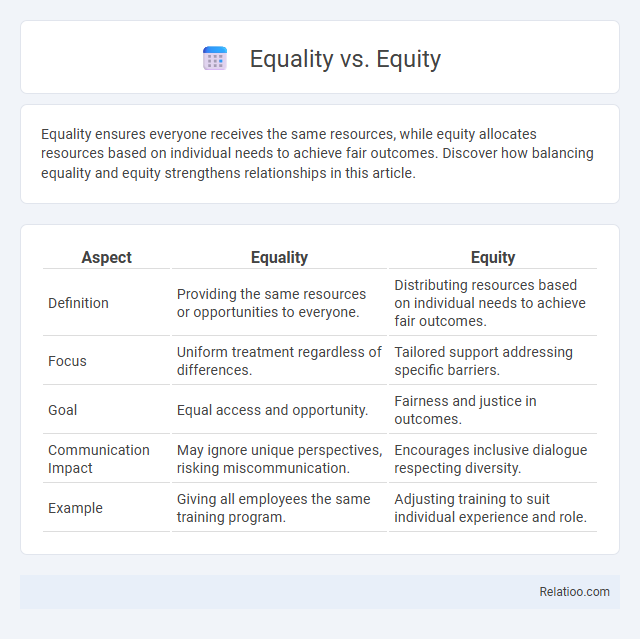Equality ensures everyone receives the same resources, while equity allocates resources based on individual needs to achieve fair outcomes. Discover how balancing equality and equity strengthens relationships in this article.
Table of Comparison
| Aspect | Equality | Equity |
|---|---|---|
| Definition | Providing the same resources or opportunities to everyone. | Distributing resources based on individual needs to achieve fair outcomes. |
| Focus | Uniform treatment regardless of differences. | Tailored support addressing specific barriers. |
| Goal | Equal access and opportunity. | Fairness and justice in outcomes. |
| Communication Impact | May ignore unique perspectives, risking miscommunication. | Encourages inclusive dialogue respecting diversity. |
| Example | Giving all employees the same training program. | Adjusting training to suit individual experience and role. |
Understanding Equality and Equity
Equality involves providing the same resources or opportunities to everyone, ensuring uniform treatment regardless of individual circumstances. Equity focuses on recognizing diverse needs and allocating resources or support proportionally to achieve fair outcomes for all individuals. Understanding these concepts clarifies that equality aims for sameness, while equity targets fairness by addressing systemic disparities.
Definitions: Equality vs. Equity
Equality ensures everyone receives the same resources or opportunities, treating all individuals identically regardless of their unique circumstances. Equity involves distributing resources based on individual needs to achieve fair outcomes, acknowledging that different people face different barriers. Understanding the distinction between equality and equity is crucial for creating effective policies that address systemic disparities.
Historical Context of Equality and Equity
The historical context of equality traces back to movements advocating for equal rights regardless of race, gender, or social status, emphasizing uniform treatment under the law. Equity emerged later as a response to the limitations of equality, recognizing systemic barriers and the need for tailored resources to achieve fair outcomes. These concepts highlight the evolution from a one-size-fits-all approach to addressing deep-rooted disparities through nuanced strategies.
Key Differences Between Equality and Equity
Equality focuses on providing the same resources and opportunities to everyone regardless of their starting point, while equity involves distributing resources based on individual needs to achieve fair outcomes. You must understand that equality assumes uniformity in needs and circumstances, whereas equity acknowledges diversity and structural barriers. Inclusion complements both by ensuring everyone feels valued and integrated within a community or organization.
Importance of Equity in Modern Society
Equity ensures fair treatment by recognizing diverse needs and allocating resources to eliminate barriers, which is vital in advancing social justice beyond mere equality. Your commitment to equity fosters an inclusive environment where all individuals have the opportunity to thrive regardless of their starting point. Prioritizing equity in modern society leads to sustainable economic growth, improved health outcomes, and stronger community cohesion.
Real-Life Examples of Equality and Equity
Equality means providing everyone with the same resources or opportunities, such as schools giving all students identical textbooks regardless of their individual needs. Equity recognizes that different people require tailored support to achieve fair outcomes, like offering extra tutoring to students from disadvantaged backgrounds to bridge learning gaps. Your understanding of these concepts can improve decision-making in education, workplace policies, and social programs, ensuring fair treatment and access for diverse groups.
Benefits of Promoting Equity Over Equality
Promoting equity over equality ensures that resources and opportunities are tailored to individual needs, fostering a more effective and fair environment where everyone can thrive. Your organization benefits from increased productivity, higher employee morale, and reduced disparities, creating a culture of belonging and respect. Equity addresses systemic barriers, enabling sustainable growth and innovation by empowering diverse perspectives and talents.
Common Misconceptions About Equality and Equity
Common misconceptions about equality and equity often conflate treating everyone the same with providing fair opportunities, ignoring that equality means uniform distribution while equity involves tailoring resources to individual needs. Misunderstandings arise when equity is perceived as giving unfair advantages, rather than addressing systemic disparities to achieve balanced outcomes. Recognizing that equality emphasizes sameness and equity targets fairness is essential for effective diversity and inclusion strategies.
Challenges in Achieving Equality and Equity
Challenges in achieving equality and equity include systemic biases ingrained in institutions that hinder fair access to opportunities for marginalized groups. Economic disparities and unequal resource distribution complicate efforts to provide equitable support tailored to specific needs. Overcoming deep-rooted cultural norms and resistance to change remains a significant barrier to implementing effective policies that promote both equality and equity.
Moving Forward: Strategies for Balanced Inclusion
Moving forward with balanced inclusion requires implementing strategies that address equality, equity, and inclusion collectively. Your organization can develop targeted policies that ensure fair resource distribution (equity), promote uniform opportunities (equality), and foster a culture where diverse voices are valued and integrated (inclusion). Leveraging data-driven approaches and continuous feedback loops accelerates progress toward creating inclusive environments that support all individuals equally.

Infographic: Equality vs Equity
 relatioo.com
relatioo.com